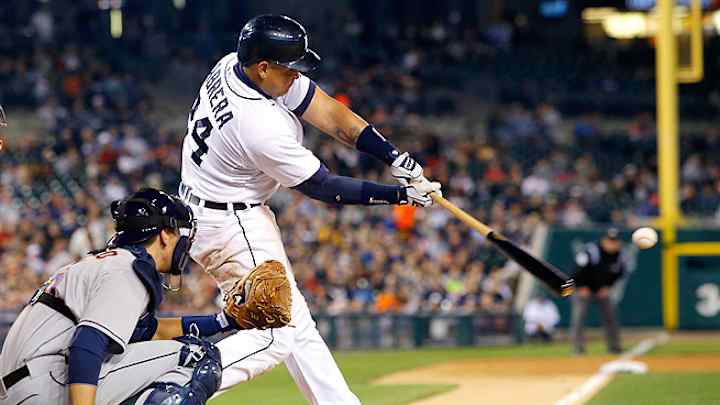Fantasy baseball Stat Focus: Cabrera's wOBA illustrates his dominance


Pick any offensive statistic and chances are that Miguel Cabrera is at or near the top spot on the leaderboard. He's hitting .384, No. 1 in the majors, and his .667 slugging percentage also ranks first. His OBP is all the way down in second place at .455, tied with Shin-Soo Choo and trailing only Joey Votto. He's fourth in the league with 12 homers and first in RBI with 49. His .287 isolated power, which we discussed a few weeks ago with regard to Chris Davis, ranks sixth. No matter what stat you prefer to measure hitters by, Cabrera is having another incredible season.
WEEK 8 PREP: Fantasy baseball Weekend Spotlight | Weekly Planner | Waiver Wire | Pitching Report | Injury Report | Trade Tips | Roundtable | Advanced Stats Focus | Prospect Watch
Wouldn't it be nice, though, if there was one statistic that caught all of the above sand wrapped them into one nice, neat number? I mean if there was, it could have saved me about 100 words in the paragraph above. Well luckily for us, that statistic does exist. It's called weighted on-base average, or wOBA, and it illustrates not only how dominant Cabrera has been this year in comparison to his peers, but also why he deserved to be the AL MVP last season.
At this point in human evolution, everyone this side of Hawk Harrelson and Joe Morgan has come to accept that batting average is a faulty stat. It doesn't give hitters any credit for taking walks, and it treats all hits the same. It doesn't take a baseball genius to understand that a single is not as valuable as a home run. However, OBP, the original holy grail of the sabermetric community, has the same drawback. Slugging percentage helps us determine how proficient a player is at hitting for extra bases, but it, too, has its problems. Is a double demonstrably twice as valuable as a single? Does a triple have 50 percent more value than a double? No, it doesn't. But it does when calculating slugging percentage. OPS goes one step better by combining OBP and slugging, but it still suffers from the flaws inherent in the original statistics.
GALLERY: Classic photos of Miguel Cabrera
On the other hand, wOBA applies a weighted value, measured in runs, to everything a hitter can do, and spits out a number that looks like any of the three in a typical slash line. The weight of hitter outcomes -- walks, hits by pitch, singles, doubles, triples and homers -- are determined using linear weights. In short, linear weights measure how many runs each of the above outcomes will produce depending on situation. Without getting too deep in the muck here, we can see that a single will generally produce fewer runs than a double, which will produce fewer runs than a home run. A homer may not be four times as valuable as a single. After all, a single with a man on third produces one run. A homer with a man on third produces two. But it always will be more valuable. Linear weights do an admirable job of capturing just how much more valuable a homer is than a single. And by using them to calculate wOBA, we have the best catchall stat for hitters that we could possibly get with the tools at hand.
Now that we have some background information on wOBA, let's get back to Cabrera. As we said earlier, he leads the world in many meaningful hitting stats, and is close to the top in all the ones he doesn't lead. As you probably could have guessed, he also leads the league in wOBA, posting a ridiculous .472 mark to this point. Chris Davis is second, a full 30 points behind him at .442. Choo and Votto are tied in third at .430. Cabrera may not be able to sustain a .472 wOBA all season. Going back to 2010, the top three full-season wOBAs have been .445 (Josh Hamilton, 2010), .443 (Jose Bautista, 2011) and .438 (Votto, 2010). In that same timeframe, Cabrera has never ranked worse than third in the majors. His worst wOBA since 2010? Last year's .417, which just happened to lead the league, four points ahead of Ryan Braun and eight points ahead of Mike Trout. Cabrera is the best hitter on the planet. You may not have needed another statistic to tell you that, but now you have one that gives you the definitive case.
